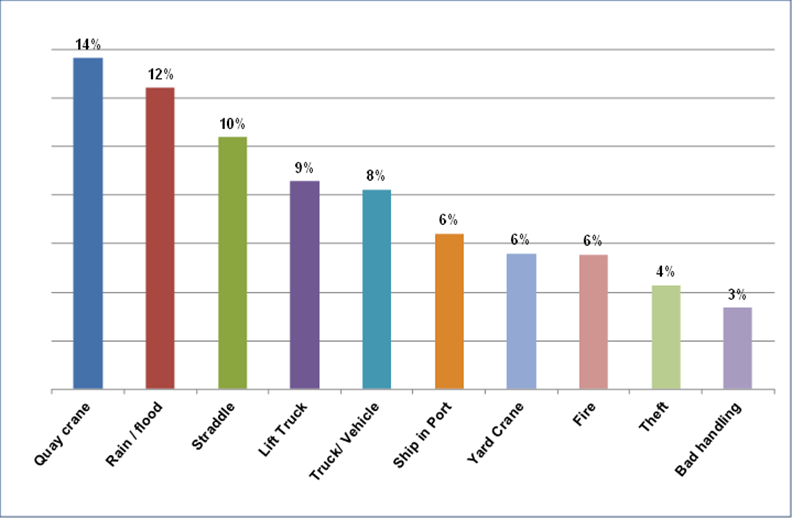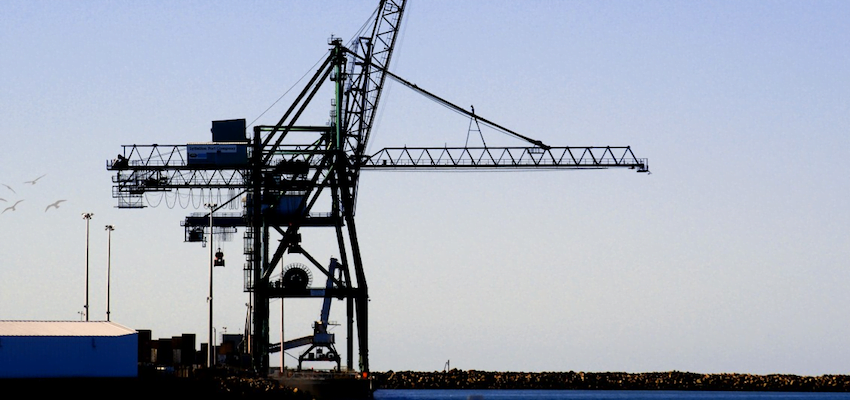INEVITABLY there are occasions where incidents are fortuitous and unavoidable and that is the key reason for buying insurance. However, TT Club has released its top rating risk categories by insurance claim for container terminal operators, to help improve safety and strengthen risk management practices.
# 1 risk – incidents related to quay cranes
Inevitably, in container operations, the crane that is usually positioned near the edge of the quay is both a key asset and hugely vulnerable. It has remained for a number of years the single most costly insurance claim, with all-too-frequent incidents involving boom collisions, gantry collisions or stack collisions. Due to their importance it may be surprising that currently economically viable technologies are not more widely adopted.
# 2 risk – rain & flood damage
It may be difficult to avoid the path of a storm, but much can be done to mitigate the potential and resultant damage. While it is critical to secure and tie assets, such as cranes, or revise container stacks in the yard, a key risk remains storm surge and floods in general. Marine terminals are necessarily low-lying, so positioning more valuable equipment or goods to higher ground mitigates the risks.
# 3 risk – straddle carriers
Manual straddle collisions and overturns, besides causing damage, usually result in serious bodily injuries. Like most incidents, these are commonly due to human error. While these are top-heavy items, with inevitable blind-spots, there are monitoring technologies available to ensure mechanical performance and also support user behaviour and training.
# 4 risk – lift trucks
This classification includes fork lifts, empty handlers, top picks, side picks, reach stackers etc. While risks are various, one that stands out is injuries to pedestrians. Keeping people away from machines is a simple mantra; where unavoidable procedures and technologies need to protect those at risk.

# 5 risk – truck and vehicles
Other smaller vehicles, including internal transfer vehicles, third party trucks and all other vehicle on the terminal require good traffic management procedures and enforcement. Collisions and overturns remain all too common.
Other smaller vehicles, including internal transfer vehicles, third party trucks and all other vehicle on the terminal require good traffic management procedures and enforcement. Collisions and overturns remain all too common.
# 6 risk – ship in port
While a most welcome visitor to a port, ships are sadly prone to collide with the berth and on many occasions the crane as well. This has happened at least twice in the last month. The terminal may have little control, although clear procedures and communications between all stakeholders may reduce the likelihood of such incidents.
# 7 risk – yard crane
The main risk with yard cranes is stack collisions – the spreader or a container under the spreader colliding with another container in the stack. This can result in stack collapses causing crane, container and cargo damage. However, the greatest concern is the injuries often resulting when a container falls on a waiting truck.
# 8 risk – fire
Fires can be devastating and have various causes. Notably, some 44% of the fire cost in container terminals arises amongst lift trucks; these need detection and suppression systems in the engine compartments, as well as assiduous attention to proper maintenance.
# 9 risk – theft
TT Club and BSI recently published their annual theft report; while generic, this highlighted the ‘insider’ risk, which is particularly prevalent in the terminal environment. Furthermore, the Club has previously highlighted the increasing use of cybercrime to aid physical theft. Physical and system security is clearly paramount, alongside continuing awareness training and thorough checks for those allowed on site.
# 10 risk – bad handling
Cargo in the custody of the terminal may become damaged – such as an overturn where out of gauge cargo is moved without use of the requisite low loader. However, terminals also need to maintain robust records in order to defend claims that may be asserted erroneously for which evidence of condition at entry and exit is required.

